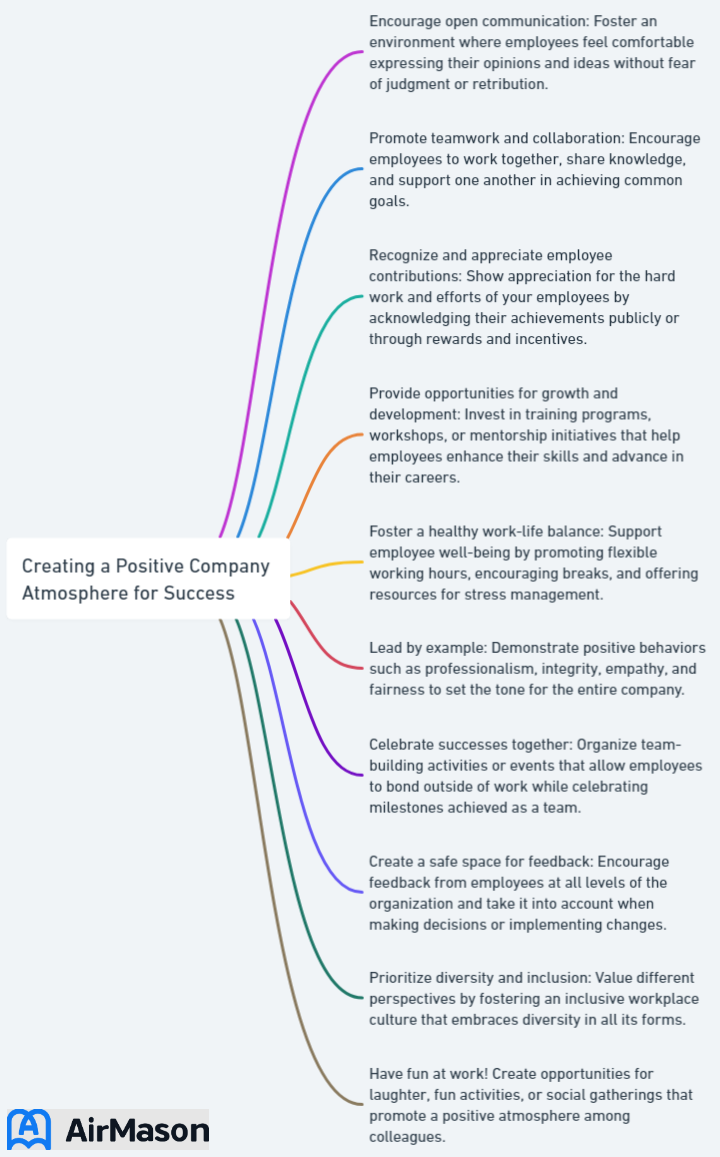
In today’s fast-paced business world, a positive company atmosphere is not just a nice-to-have; it’s a vital ingredient for success. A healthy work environment can make or break a company’s performance, employee retention, and overall growth. But what makes a work atmosphere truly positive, and how can businesses ensure they’re fostering the right conditions? In this blog post, we will explore the importance of a positive company atmosphere, its key components, and how to build a strong company culture. We’ll also discuss practical strategies for creating a positive work environment, even in remote and hybrid settings.
Key Takeaways
- Creating a positive company atmosphere leads to increased productivity and employee retention.
- Key components include effective communication, recognition & appreciation of employees, and opportunities for growth.
- Strategies involve prioritizing work-life balance, creating comfortable workspaces, leveraging technology for remote teams & investing in employee well-being.
The Importance of a Positive Company Atmosphere
Business success in any environment often thrives on a positive atmosphere; it leads to higher productivity, improved employee retention, and better teamwork and collaboration. A positive work environment can bring about numerous benefits, such as increased productivity, creativity, and stress reduction. Additionally, it can foster strong company loyalty, boost staff confidence and enthusiasm, and lead to employees performing at their best, knowing they will be acknowledged and rewarded, making employees feel valued.
Creating a positive company atmosphere involves empathy and compassion, recognizing characteristics of a positive work environment, and reducing absenteeism and workers’ compensation and medical claims. Businesses can contribute to employee development and success by focusing on work-life balance, creating a comfortable workspace, investing in employee well-being, utilizing technology for communication and collaboration, nurturing virtual connections, and providing adequate support and recognition.

Enhanced productivity
A positive work environment has been shown to increase employee motivation and efficiency, thereby resulting in higher productivity levels and higher job satisfaction. Adapting to external business environments and investing in new equipment and software can also increase productivity and minimize costs, which is a great asset to a company. On the other hand, negativity in the workplace can have a detrimental effect on employees’ morale and enthusiasm for their work, resulting in decreased productivity and creating a negative work environment.
Companies can modify their internal policies and business strategy in response to a higher employee turnover rate or decreased productivity. By creating an environment that fosters motivation, innovation, and creativity, businesses can unlock their full potential, becoming industry leaders in their respective fields.
Improved employee retention
Reduced turnover rates are often a result of a positive work environment, as employees tend to stay with a company that values their well-being and happiness, which in turn improves their performance. Replacing an employee who departs due to an unsatisfactory work environment can incur costs of up to twice their salary, which can negatively impact a company’s success.
Effective employee recognition can:
- Create enthusiasm
- Foster innovation
- Strengthen trust
- Contribute to positive financial outcomes
This makes the workplace feel like a positive atmosphere tv show. Expressing gratitude to employees can have a transformative and elevating effect on an organization, regardless of the political environment. Acknowledging an employee’s efforts, even if it is something as simple as expressing thanks, can have a significant impact when they have gone the extra mile or worked additional hours, showing how the work atmosphere affects employee motivation.
A supportive and engaging atmosphere has a positive effect on turnover rates, as employees are more likely to remain with a company that values their wellbeing and satisfaction. By cultivating a supportive and engaging atmosphere, businesses can not only improve employee retention but also foster a more innovative and resilient workforce.
Better teamwork and collaboration
An atmosphere filled with positivity can stimulate collaboration and innovation by nurturing strong relationships among team members. The advantages of strong teamwork and collaboration in the workplace are numerous:
- Problem-solving is enhanced by the sharing of ideas and perspectives.
- Learning and growth opportunities are created through employees’ ability to learn from each other.
- Productivity is increased through better coordination and division of tasks.
- Innovation is unlocked through the combination of different skills and perspectives.
- A more positive atmosphere is created through collaboration, making the workplace more enjoyable and rewarding.
Target and Asana are two examples of companies that demonstrate strong teamwork and collaboration due to a positive atmosphere. A positive atmosphere in a team setting can:
- Motivate and inspire team members
- Promote collaboration and open communication
- Foster a feeling of psychological safety
- Cultivate a supportive and inclusive environment
- Contribute to innovation.
An Organization’s Culture
An organization’s culture encompasses the shared values, beliefs, and behaviors that shape its identity and guide the interactions among its members. It serves as the foundational framework upon which all decisions, both big and small, are made. This culture is reflected in the way employees collaborate, communicate, and approach their work. Moreover, an organization’s culture plays a pivotal role in attracting and retaining talent, as individuals tend to seek environments that align with their own values and aspirations. It is imperative for leaders to actively cultivate and nurture a positive and inclusive culture, as it directly influences the overall morale, productivity, and ultimately, the success of the organization. A strong and healthy organizational culture can lead to increased innovation, adaptability to change, and a heightened sense of purpose among its members.
Key Components of a Positive Company Atmosphere

Creating a positive work environment hinges on effective communication, employee recognition, appreciation, and providing opportunities for growth. Effective communication plays a key role in creating a productive work environment by ensuring all individuals are aware of their roles and responsibilities, establishing a culture of constructive communication, enhancing collaboration and employee engagement, strengthening the bond among colleagues, and helping to resolve any issues quickly.
Opportunities for professional growth can be highly beneficial to a positive work environment, as they:
- Motivate employees to further develop their skills and progress their careers
- Provide guidance, support, and learning from experienced leaders and mentors
- Boost team morale
- Contribute to a positive company culture
- Improve problem-solving efforts through collaboration
Furthermore, professional development can help improve employee retention, productivity, and attract top job applicants.
Effective communication
Transparent and open communication builds trust and reduces misunderstandings, thereby contributing to a more productive work atmosphere. Effective communication can foster trust and minimize misunderstandings, leading to an environment of cooperation and productivity.
Effective communication can be beneficial for resolving conflicts in the workplace by:
- Providing opportunities to address issues promptly and candidly
- Setting clear expectations
- Cultivating active listening skills
- Employing neutral language and open body language.
By investing in open communication, businesses can create a positive work atmosphere where employees feel valued and supported, ultimately leading to higher job satisfaction and improved performance.
Employee recognition and appreciation
Regularly acknowledging employees’ efforts and achievements fosters a sense of belonging and motivates them to reach their maximum potential. Acknowledging employees’ efforts and accomplishments on a regular basis promotes a sense of inclusion and encourages them to strive for excellence. It creates a feeling of inclusion and encourages employees to reach their full potential.
By regularly recognizing and appreciating employees, businesses can foster a positive work atmosphere where workers feel valued and motivated to perform at their best. This not only contributes to improved employee performance but also helps to create a strong company culture that attracts top talent and retains valuable employees.
Opportunities for personal and professional growth
Providing continuous learning and growth opportunities for staff members helps them feel valued and engaged, thus enhancing the work environment. Offering employees learning and development opportunities can help them feel appreciated and motivated, thereby strengthening a positive work atmosphere.
Providing opportunities for personal and professional growth not only benefits employees but also contributes to the overall success of the company. By investing in the development of their workforce, businesses can create a more innovative, productive, and competitive organization that is better equipped to adapt to the ever-changing business environment.
Supportive Work Culture
A supportive work culture is the cornerstone of a thriving and productive workplace environment. It encompasses an array of values and practices that prioritize the well-being and growth of employees. In a setting with a supportive work culture, team members feel valued and respected, fostering a sense of belonging and loyalty. This culture encourages open communication, constructive feedback, and the recognition of individual contributions, leading to increased morale and job satisfaction. Furthermore, it creates an atmosphere where employees are empowered to take risks, innovate, and develop their skills, ultimately driving the organization towards success. Implementing and nurturing a supportive work culture is not only beneficial for the employees’ professional development but also leads to improved organizational performance and achievement of long-term goals.
Building a Strong Company Culture

Building a robust company culture relies on well-defined core values, active employee involvement, and a dedicated commitment to diversity and inclusion. The foundation of a robust company culture lies in defining core values, encouraging employee engagement, and upholding a dedication to diversity and inclusion.
By focusing on these essential components, businesses can create a positive work atmosphere that not only fosters employee satisfaction and productivity but also sets the stage for long-term success. A strong company culture that prioritizes employee well-being and engagement can become an invaluable asset, helping businesses to attract and retain top talent, drive innovation, and maintain a competitive edge in the marketplace.
Defining core values
The establishment and communication of the company’s core values aid in fostering a unified sense of purpose and direction. Core values are a major factor in company culture and employee behavior. When core values are clearly defined and communicated, they form the basis of the organization’s culture.
Employees who identify with the core values are more likely to experience a sense of belonging and purpose, leading to enhanced engagement and motivation. Core values also act as a guide for decision-making and behavior, affecting how employees interact with each other, customers, and stakeholders.
In essence, core values create a shared set of principles and beliefs that shape the attitudes and actions of employees, thereby fostering a positive company atmosphere and driving success.
Encouraging employee involvement
Promoting employee participation in decision-making and insight sharing fosters a sense of ownership and commitment to the company’s success. Companies can facilitate employees expressing their opinions and ideas by:
- Setting up a company intranet with a blog
- Leveraging digital communication platforms
- Administering surveys
- Conducting one-on-one conversations with management
- Motivating employees to share their opinions and feedback
Taking into account employee feedback when making company decisions and policies has numerous advantages, such as:
- Enhanced performance
- Heightened employee engagement
- Heightened awareness of the office environment
- Retention
- Improved decision-making
- Enhanced communication
By actively involving employees in the decision-making process and encouraging open communication, businesses can build a strong company culture that fosters a sense of belonging, commitment, and innovation.
Promoting diversity and inclusion
Promoting diversity and inclusion can stimulate creativity and resilience within the workforce. Embracing diversity and fostering an inclusive environment in the workplace can lead to a more innovative, adaptable, and successful organization. Businesses can effectively promote diversity and inclusion in the workplace by:
- Being cognizant of unconscious bias
- Educating managers
- Crafting inclusive policies
- Emphasizing the importance
- Ensuring pay equity
- Designing training programs
- Recruiting inclusive leaders
- Maintaining an open mind
- Allowing opportunities for employee input
- Recognizing cultural diversity
By promoting diversity and inclusion, businesses can:
- Create a more positive work atmosphere
- Benefit from the unique perspectives, skills, and experiences that a diverse workforce brings to the table
- Lead to greater innovation
- Improve problem-solving
- Ultimately, create a more successful and resilient organization.
Strategies for Creating a Positive Work Environment

Key strategies for fostering a positive work environment include prioritizing work-life balance, creating a comfortable workspace, and investing in employee well-being. Implementing work-life balance initiatives, furnishing a comfortable workspace, and investing in employee well-being are essential for creating a positive work environment.
By focusing on these key strategies, businesses can create a positive work atmosphere that not only benefits their employees but also contributes to the overall success of the company. A positive work environment can help to boost productivity, enhance employee satisfaction, and promote a strong company culture that drives long-term success.
Prioritizing work-life balance
Cultivating a balanced lifestyle that harmonizes an individual’s personal and professional commitments can enhance their overall well-being and job satisfaction. Fostering a culture where employees are encouraged to maintain a healthy balance between their personal and professional lives can positively impact their overall well-being and job satisfaction.
Displaying empathy is an essential element in assisting employees in attaining balance. By emphasizing the importance of work-life balance and providing employees with the resources and support they need to achieve it, businesses can create a positive work atmosphere that fosters employee well-being, satisfaction, and long-term success.
Providing a comfortable and functional workspace
Designing a workspace that caters to employees’ needs and preferences can boost productivity and morale. Notable examples of well-designed workspaces in successful companies include ANZ Bank, Treehouse, and Bumble. These examples illustrate the significance of constructing comfortable and functional workspaces that foster collaboration, creativity, and productivity.
By providing a comfortable and functional workspace, businesses can create a positive work atmosphere that enables employees to perform at their best. This not only contributes to improved employee performance and satisfaction, but also helps to create a strong company culture that attracts top talent and retains valuable employees.
Investing in employee well-being
Offering resources and support for the physical, mental, and emotional well-being of employees is a reflection of a company’s commitment to their overall happiness and success. Investing in employee well-being can be achieved through:
- Granting workers more autonomy in their work
- Providing flexibility in their work schedule
- Emphasizing physical and mental health
- Enabling employees to address workplace issues
- Creating a sense of social connectedness
- Offering career development opportunities
By investing in the well-being of their employees, businesses can create a positive work atmosphere that fosters employee satisfaction, engagement, and productivity. This not only benefits individual employees but also contributes to the company’s success, driving innovation, growth, and long-term resilience.
How to Maintain Company Culture
Maintaining a strong company culture is crucial for fostering a positive work environment and ensuring employee satisfaction and productivity. To effectively sustain company culture, it’s imperative to start by clearly defining the core values and principles that guide the organization. These values serve as the foundation upon which all decisions and actions are based. Regular communication is equally vital, as it keeps employees aligned with the company’s mission and goals. This can be achieved through town hall meetings, newsletters, and open forums for feedback. Moreover, leaders should lead by example, embodying the desired culture through their behavior and actions.
Adapting to Remote and Hybrid Work Environments

Utilizing technology, encouraging virtual connections, and delivering consistent support and recognition are crucial for fostering a positive atmosphere in remote and hybrid work environments. By effectively using these strategies, remote teams can foster virtual connections, boost collaboration, and create a positive company atmosphere for success.
In today’s increasingly remote and hybrid work settings, it is more important than ever for businesses to adapt their strategies and practices to maintain a positive work atmosphere. By embracing technology, promoting virtual connections, and ensuring consistent support and recognition, businesses can continue to foster a positive work environment that benefits both their employees and their overall success.
Leveraging technology for communication and collaboration
Utilizing digital tools and platforms can help maintain effective communication and facilitate collaboration among remote team members. Some examples of digital platforms that can enhance team collaboration in a remote setting include:
- Slack: for improved communication and real-time messaging
- Zoom: for video conferencing and virtual meetings
- Trello: for efficient project management and task tracking
- SpatialChat: for virtual collaboration and interactive meetings
By utilizing these digital tools and platforms, remote teams can experience enhanced communication, improved document sharing and collaboration, increased flexibility and accessibility, efficient project management, and facilitated knowledge sharing.
By leveraging technology for communication and collaboration, businesses can create a positive work atmosphere in remote and hybrid work settings where employees feel valued, supported, and connected. This not only contributes to improved employee performance and satisfaction but also helps to create a strong company culture that drives long-term success.
Fostering virtual connections
Encouraging virtual social interactions and team-building activities can help maintain strong bonds and a sense of unity among remote workers. Some effective virtual team-building activities include:
- Virtual scavenger hunts
- Online office games
- Hot seat activities
- Classic game nights on video conference platforms
- Mystery rounds
- One truth and one lie games
- Virtual movie nights
The challenges associated with facilitating virtual connections in remote work settings include physical separation, reduced face-to-face contact, and limited chances for casual interactions and team building. These issues can be addressed by utilizing technology for communication and collaboration, scheduling regular virtual team-building activities, providing sufficient technical support and resources, and cultivating inclusivity and open communication within the team.
Ensuring consistent support and recognition
Providing regular feedback, recognition, and support to remote employees is crucial for maintaining their motivation and engagement. Several tools exist for providing regular feedback and recognition to remote employees, such as:
- Kazoo
- Reflektive
- Timely
- Officevibe
- Leapsome
By providing consistent support and recognition to remote employees, businesses can maintain a positive work atmosphere that fosters employee satisfaction, engagement, and productivity. This not only benefits individual employees but also contributes to the overall success of the company, driving innovation, growth, and long-term resilience.
Summary
In conclusion, a positive company atmosphere is essential for business success, employee satisfaction, and long-term growth. By focusing on key components such as effective communication, employee recognition and appreciation, and opportunities for personal and professional growth, businesses can create a positive work environment that fosters a strong company culture, drives innovation, and attracts top talent. Adapting to remote and hybrid work environments requires leveraging technology, fostering virtual connections, and ensuring consistent support and recognition. By prioritizing these strategies, businesses can continue to thrive in today’s ever-changing business landscape, creating a positive company atmosphere that benefits both employees and the organization as a whole.
Frequently Asked Questions
What is the atmosphere of a company?
The atmosphere of a company is typically defined by its interactions, attitudes, and emotions. It is often simply described as ‘good’ or ‘bad’.
What is a good atmosphere in business?
Creating a workplace atmosphere of trust, cooperation, safety, support for risk-taking, accountability, and equity is key to having a successful business.
What are the 3 most important things in a working environment?
A working environment should be based on respect, teamwork, training, communication, and opportunity for all employees to thrive. This will create a productive and collaborative atmosphere that leads to success.
How can businesses promote diversity and inclusion in the workplace?
Businesses can create a more inclusive workplace by recognizing unconscious bias, providing educational opportunities, crafting policies and training programs with diversity in mind, maintaining pay equity, recruiting diverse leaders, and giving employees a chance to provide input.
What are some effective virtual team-building activities for remote employees?
Virtual scavenger hunts, office games, hot seat activities, classic game nights, mystery rounds, one truth and one lie games, and virtual movie nights are effective virtual team-building activities for remote employees.